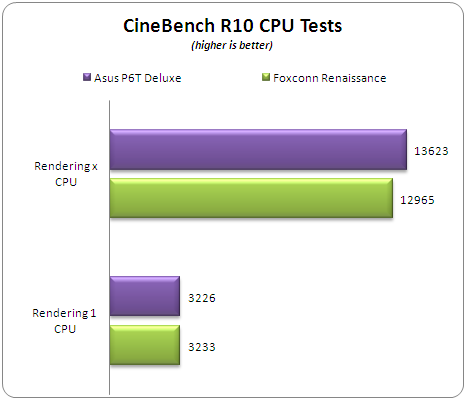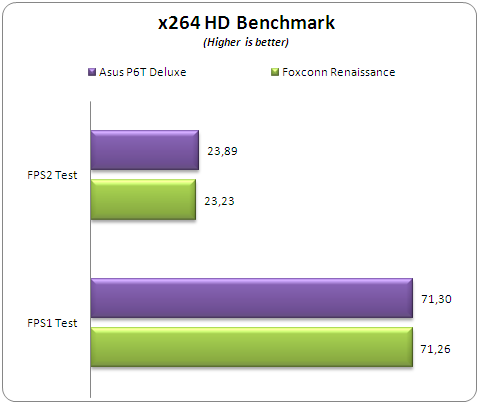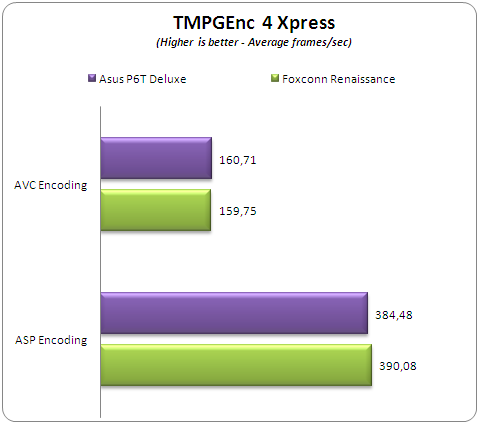Asus P6T Deluxe Vs Foxconn Renaissance
10. Benchmarks - MAXON CINEBENCH, x264 HD Benchmark, TMPGEnc 4 Xpress
Review Pages
2. Asus P6T Deluxe/OC Palm Edition - Opening the box
3. Asus P6T Deluxe/OC Palm Edition - BIOS
4. Foxconn Renaissance - Specifications
5. Foxconn Renaissance - Opening the box
6. Foxconn Renaissance - BIOS
7. Testbed
8. Benchmarks - Everest Ultimate Edition, SiSoftware Sandra
9. Benchmarks - PCMark Vantage, BAPCo's SYSmark 2007 Preview
10. Benchmarks - MAXON CINEBENCH, x264 HD Benchmark, TMPGEnc 4 Xpress
11. Benchmarks - SuperPI, wPrime
12. Benchmarks - 3DMark 06, Crysis v1.2
13. Overclocking tests - Asus P6T Deluxe
14. Overclocking tests - Foxconn Renaissance
15. Conclusion
 MAXON CINEBENCH is based on MAXON's award-winning animation software, CINEMA 4D, which
is used by studios and production houses worldwide for 3D
content creation. The software runs several tests on your computer to measure the
performance of the main processor and the graphics card under real
world circumstances. The benchmark application makes use of up to 16
CPUs or CPU cores and is available for Windows (32-bit and 64-Bit) and
Macintosh (PPC and Intel-based). The resulting values among different
operating systems are 100% comparable.
MAXON CINEBENCH is based on MAXON's award-winning animation software, CINEMA 4D, which
is used by studios and production houses worldwide for 3D
content creation. The software runs several tests on your computer to measure the
performance of the main processor and the graphics card under real
world circumstances. The benchmark application makes use of up to 16
CPUs or CPU cores and is available for Windows (32-bit and 64-Bit) and
Macintosh (PPC and Intel-based). The resulting values among different
operating systems are 100% comparable.

The Foxconn Renaissance gave a slightly better performance in the single CPU rendering test. But when the CineBench R10 benchmark used all the cores of the Core i7-920 processor, the Asus P6T Deluxe/OC Palm had a clear advantage and took the lead.
- x264 HD Benchmark
x264 Benchmark utilizes the next generation of Video Encoding benchmarks with support for x264 codec that is considered to be one of the most demanding for Video applications. Simply put, it is a reproducible measure of how fast your machine can encode a short, HD video clip to a high quality x264 video file. It's nice because everyone running it will use the identical video clip and software. The video encoder (x264.exe) reports a fairly accurate internal benchmark (frames per second) for each pass of the video encode and it also uses multi-core processors very efficiently.
The benchmark procedure is very simple. You just run a batch file that encodes the same file four times. The average performance for each encoding pass are posted below:

A small lead for the Asus motherboard here, especially in the FPS2 test.
- TMPGEnc 4 Xpress
The TMPGEnc takes advantage of all the resources of your CPU during encoding a file. Encoding time will automatically be faster as CPU speed gets faster! TMPGEnc converts *.AVI files to MPEG1, the format which is used in VideoCDs. Using a variety of options in TMPGEnc, you can compress your video file in high quality.
For our test we used a 350MB AVI file encoded with the Xvid (Mpeg4 ASP) codec. We used the built- in Mpeg4 ASP/AVC MediaEncoder profile and we post the the average encoding speed (frames per second) of each processor.
Review Pages
2. Asus P6T Deluxe/OC Palm Edition - Opening the box
3. Asus P6T Deluxe/OC Palm Edition - BIOS
4. Foxconn Renaissance - Specifications
5. Foxconn Renaissance - Opening the box
6. Foxconn Renaissance - BIOS
7. Testbed
8. Benchmarks - Everest Ultimate Edition, SiSoftware Sandra
9. Benchmarks - PCMark Vantage, BAPCo's SYSmark 2007 Preview
10. Benchmarks - MAXON CINEBENCH, x264 HD Benchmark, TMPGEnc 4 Xpress
11. Benchmarks - SuperPI, wPrime
12. Benchmarks - 3DMark 06, Crysis v1.2
13. Overclocking tests - Asus P6T Deluxe
14. Overclocking tests - Foxconn Renaissance
15. Conclusion






















